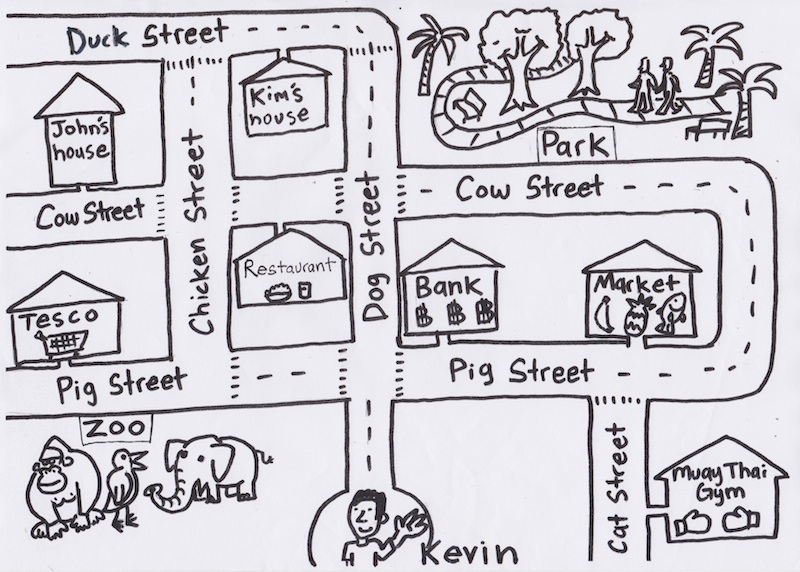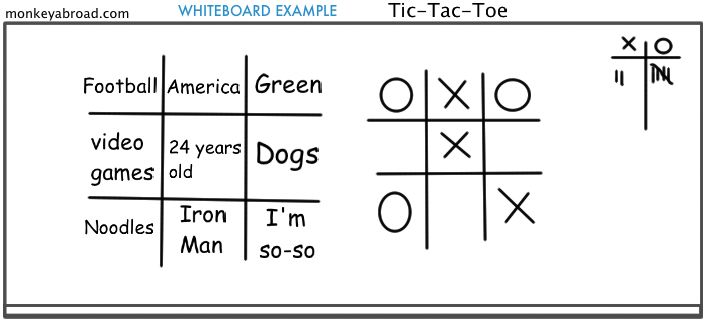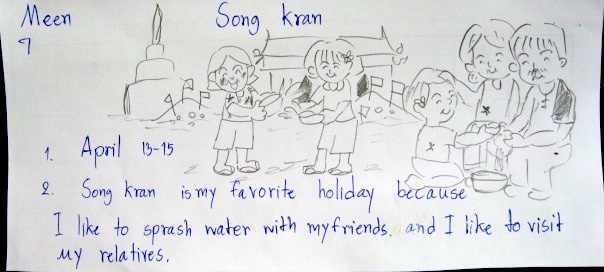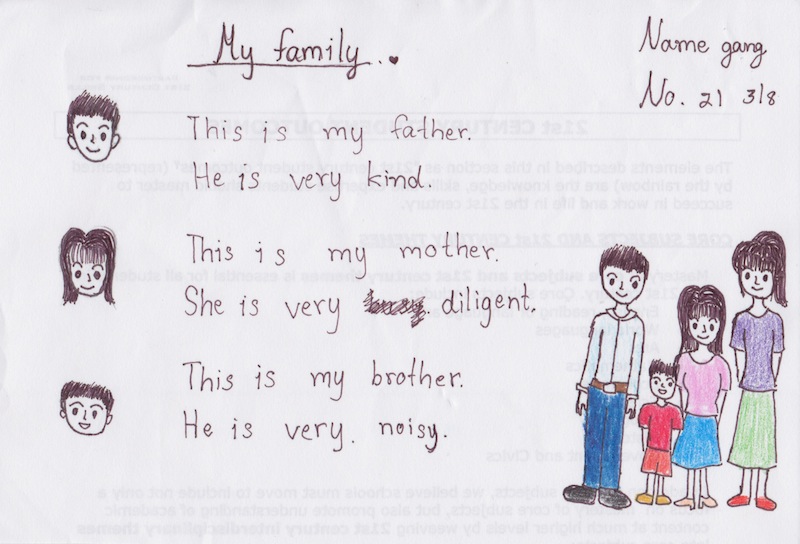I work at a high school in Thailand and my job is to teach obscenely large classes. One thing I’ve learned: handling a hoard of 40-50 students in a single classroom requires games. A whole mess of games. Unless you’ve got a few activities in your back pocket at all times, the classroom might turn into a scene from Lord of the Flies. To prevent that from happening, you can always refer to this list of 27 proven ESL games for large classes.
Kevin’s List of Proven ESL Games for Large Classes
Most of these games require little more than a whiteboard/blackboard and your imagination. Keep score by writing tally marks on the board. You can use JetCalculator to calculate your game plan.
1. Introduction Games
- ——Game 1——–
- A perfect game for the first day of school.
- Break the class into 4 to 5 teams.
- Recite a short story about yourself listing 15 to 20 facts about where you’re from, your hobbies, etc.
- After you recite the story, ask the class questions about specifics from your story.
- The team who answers the most questions correctly wins.
- ——Game 2——-
- Tell the class a few facts about yourself.
- Stuff like… Name, where you’re from, hobbies, birthday, expectations for the semester.
- Then, give the class 10 to 15 minutes to write their own.
- Collect the student’s papers and drop them in a hat.
- Randomly draw the student’s fact sheets.
- Ask the students to come to the front of class and read their list aloud.
- This game is good for advanced students.
2. Word Relay
- Break the class into 2 teams, each team forms a line to the whiteboard.
- The first student in line writes a word. The next student in line writes a word that begins with the last letter of the previous word.
- Turtle, elephant, turn, neighbor, read, draw, … until every student from a particular team has written a word.
- Make the game difficult by changing the variables (4-letter words only, nouns only, 5-letter words only, etc.)
3. Tongue Twister Showdown
- Prepare a list of tongue twisters and print off two copies of each one. Have at least 15 tongue twisters prepared.
- Cut out each tongue twister onto a slip of paper, each with 2 copies.
- Break the class into 2 teams.
- Have one student from each team come to the front of class.
- Hand each student the same tongue twister and allow both of them to try to pronounce it correctly.
- The student with best pronunciation earns their team a point.
4. Pictionary
- Prepare a list of vocabulary words that the students should be familiar with.
- Break the class into 2 teams.
- One student from each team comes to the front of class to draw.
- Teams guess what their teammate is drawing.
- Enforce a strict hand-raising rule, otherwise all hell breaks loose.
5. Sentence Showdown
- Break the class into 2 teams.
- One student from each team comes to the board to write.
- Stand in the middle of the board and write a jumbled sentence.
- monkey bananas to eat likes That (That monkey likes to eat bananas), start? does time school What (What time does school start?)
- The first student to write the sentence correctly earns a point for their team. Encourage the teams to help the writers.
- Harder sentences are worth more points. The team with the most points wins.
6. Connect Four
- Draw a 6×6 grid on the board. Over each column, write words that students typically have difficulty with.
- Right, Light, Clown, Crown, Stay, Stray, Bat, Bath, True, Through, …
- Spit the class into 2 teams: black circles and white circles.
- Draw circles in the grid corresponding with the word the student pronounces. Often times, you’ll hear light when the student wants to say right, but you must place the circle in the column of the word that you hear.
- This game forces students to pronounce problem words correctly, otherwise they’ll lose.
- Pick students at random to keep the class focused.

7. Telephone
- Break the class into 2 teams.
- Both teams form a line to the board, starting in the back of the classroom.
- Stand in the back of class and whisper a short sentence to the first student in each line.
- The students whisper the sentence all the way down the line until it reaches the front of class. The student in front of class writes the sentence on the board.
- It doesn’t count for a point unless the sentence is perfect.
8. World Traveler
- Ask the class, “If you could travel anywhere, where would you go?”
- Elicit different countries from students and write them all on the board.
- Once you’ve listed a bunch of countries on the board, break the class into 4 or 5 teams.
- Have a list of historical landmarks and their corresponding countries prepared in advance (Eiffel Tower: France, Pyramids: Egypt, Statue of Liberty: U.S.A., etc.)
- Ask the class, “Where can I visit the… (insert landmark here)?
- The team that answers the most correct questions wins.
9. Directions Game
- Draw a map (or print out my map below).
- Make enough copies for each student.
- Teach directions: go straight, turn right, turn left, opposite the…, between the…
- Pass out the maps and break the class into 4 or 5 teams.
- 2 different direction games can be played using a map:
- Telling directions: From the start, I go straight on Dog Street and turn left on Duck Street. Where am I?
- Asking directions: How do I get to the… market, retaurant, etc.?
- The team that answers the most questions correctly wins.

10. Hot Seat
- Break the class into 2 teams.
- Place a chair next to the board, facing the class.
- Students from each team rotate turns sitting in the chair.
- Write a vocabulary word behind the student that they cannot see.
- Each team has 20 seconds to elicit the word written on the board from their teammate sitting in the hot seat.
- They can only speak English. If they speak their native tongue, erase a point from their score.
11. Charades
- Break the class into 2 teams.
- Fill a hat with a bunch of vocab cut-outs listing jobs, animals, verbs, adjectives.
- Students from each team take turns coming to the front of class to perform a vocabulary word that they draw from the hat. Their team has 20 seconds to guess.
12. Fashion and Style
- Teach the class different styles and fashion for men and women.
- Goatee, beard, earrings, braids, ponytail, makeup, tank-top, t-shirt, ice skates, high heels, etc.
- Break the class into 2 to 4 teams.
- Students from each team take turns coming to the front of class to draw on the board.
- Describe a person that the student must draw (“Draw a man with a spiked hair and beard, wearing a jacket, jeans and roller skates.” etc.)
- Each article of style and fashion that the student correctly draws earns their team a point.
13. Lesson on Lyrics
- Prepare to sing a song yourself or bring a music player to class. If you play guitar/enjoy singing, this game is pure dynamite.
- Break the class into 10 to 15 teams.
- Print out the lyrics to the song and cut the lyrics into sections.
- Pass out the jumbled lyrics to each team.
- Sing/play the song for the class as many times as necessary.
- The first team to list the lyrics in the correct order wins.
14. Secret Code
- Break the class into 4 to 5 teams.
- Write a sentence on the board in secret code and write a hint next to it.
- HINT: gdkkn = hello (one letter before the correct word in the alphabet)
- Students race to decode the secret code and earn their team points.
- Experiment with different alphabet variations to keep the students on their toes.
15. Convince Me (advanced)
- Great for teaching your students the art of persuasion.
- Bring a bag of candy to class for this one.
- Teach the class different ways to convince via persuasion: if…then…, pity, flattery, etc.
- Break the class into 2 teams.
- To earn candy, a team must be more persuasive than the opposing team.
- “If you give me the candy, then I will give you 100 dollars.”
- “I’m too poor to afford candy and I’m starving. Please give me a piece of candy.”
- “You look very handsome today teacher. So can I have a piece of candy?”
- The tactics get pretty hilarious when a piece of candy is on the line.
16. Bragging Rights (advanced)
- Demonstrate a dialogue to the class on bragging. This game is great for teaching the present perfect verb tense.
- A: I’ve played football with Lionel Messi. B: So what? I’ve played football with Christiano Ronaldo. A: So what? I taught Ronaldo how to play football!
- Break the class into 2 teams.
- Give the teams a topic to prepare bragging rights (sports, money, celebrities, talents, etc.).
- Have one student from each team come to the front of class to list their bragging rights.
- Encourage outlandish ideas and exaggeration.
- The student with the funniest, most creative boasts earns a point for their team.
17. National Anthem in English
- Whichever country you’re teaching ESL, find a translation of the country’s national anthem in English.
- Print enough copies of the anthem in English for the entire class.
- Write the anthem’s difficult words on the board to prepare the students to pronounce them correctly.
- Sing the anthem in English once for the class to hear.
- Break the class into 4 or 5 teams and have them rotate singing.
- Reward the team that sings the anthem the best with candy or bonus points on their final grade.
18. Two Truths, One Lie
- Demonstrate by writing two truths and one lie about yourself on the board.
- Allow the class to guess what your lie is.
- Once they grasp the concept, give them 5 to 10 minutes to write their own list of two truths and one lie.
- Students take turns presenting their list to the class for participation points.
- The class guesses what the lie is.
19. Story Writing
- Write the first letter to a story at the top left of the board.
- Each student must contribute one word to the story, in order.
- Make a zig zag pattern through the class until every student has said one word.
- Write the word they say next in the story. The sentences must have correct grammar.
- Example: Write “The” to start the story. Point to the first student in the front row. They say, “cow” then the next student says, “runs”, …
- The story will end up as something ridiculous.
- “The cow runs fast and eats bananas while jumping over a duck in the tree. A girl eats fish every day and she is fat. I like to play guitar with my friend and we go to the mall every saturday.”
- Have the students read the story aloud once it is finished. They will all laugh because it won’t make any sense.
20. Riddles (advanced)
- This is a great warm-up activity for advanced classes.
- Write a simple riddle on the board and see if the students can guess the answer.
- “What starts with p, ends and e, and has a million letters?” – Post office.
- “What do the letter T and an Island have in common?” – They are both in the middle of water.
- “How many months have 28 days?” – All of them.
21. Tic-Tac-Toe
- Break the class into two teams: X’s and O’s
- Draw two tic-tac-toe grids on the board, side-by-side. One grid for reference and one for actually drawing X’s and O’s.
- Write a response to a question in each square (I’m great, Noodles, America, 24 years old, Green …)
- Teams rotate asking questions (How are you? What’s your favorite food? Where are you from? …)
- To keep the entire class focused, pick students at random.

22. Who’s the Best Actor?
- Prepare a short dialogue and demonstrate it in front of the class.
- Prepare a list of emotions on different slips of paper.
- Pass out copies of the dialogue to the class so each student has one.
- Review the emotions with the class: happy, sad, excited, bored, angry, etc.
- Pick two students randomly to come to the front of class and perform the dialogue.
- Each student draws an emotion from a hat and must perform the dialogue with the corresponding emotion.
- Every student must perform once to earn participation points.
- At the end of class, list the best actors/actresses on the board.
23. Opposites
- Have a list of adjectives prepared that the class should be familiar with.
- Break the class into 4 teams.
- One student from each team comes to the front of class to write on the board.
- Say an adjective from the list and each student must write the opposite adjective on the board.
- The fastest student (with correct spelling) earns their team a point.
24. Road Trip
- Ask the class, “What do we need for a road trip?”
- Each student must say one item to bring along, but every previous item must be said first.
- Student 1: Fruit. Student 2: Fruit and vegetables. Student 3: Fruit, vegetables and a cat. Student 4: Fruit, vegetables, a cat and an umbrella. Keep going until a student forgets the list.
- This activity is a great time-killer. With a large class, the list can get huge.
ESL Games for Large Classes – Art Activities
Quiet activities like drawing are a great way to get the kids active and engaged without exhausting yourself while you referee games. Plus, after a ton of games, the students will probably be ready for a change of pace themselves.
With art activities, prepare an example that you have drawn yourself. Show the class your example and they’ll grasp the concept quickly. Pass out blank sheets of paper and watch as the class becomes silent and focused on their ESL artwork.
25. Advertisement Design
- Teach the students some key marketing phrases: advertisement, sale, discount, 50% off, brand, logo, slogan, price, etc.
- Prepare an example of an advertisement to show the class.
- Give the students 20 minutes to design their ad.
- If time permits, encourage the students to present their ad to the class.
- Students who present their ad receive bonus points to their final grade.

26. Holidays
- An adaptable ESL drawing lesson.
- Create a demonstration for the class. Illustrate your favorite holiday on a piece of paper and write a few sentences about it.
- What is the holiday? When is the holiday? Why is it your favorite holiday?
- For lower level students, limit the sentences to answer the previous 3 questions.
- For advanced classes, students should write more detailed sentences.
- This game is also a great way for you to learn a thing or two about the holidays of a foreign culture.

27. Family Art
- Another adaptable ESL drawing lesson about family.
- Prepare a demo and show the class, etc.
- You can make it as difficult as you want, depending on the level of the students.
- For my lower level students, I had each student draw their family tree.
- For my highest level students, I had them draw their immediate family member and write 2 short sentences about each.
- “This is my mother. She is a very kind person because she takes care of me.” etc.
- “This is my brother. He is funny because he tells jokes.” etc.

Conclusion
You might be familiar with some of these games. Others, I created myself. I’ve personally tested each one of these ESL games and they’ve all earned my seal of approval. I hope this list gives you some ideas and inspiration. Feel free to change the variables and grammar in any of the games to suit a particular lesson. Good luck!

Leave a Reply